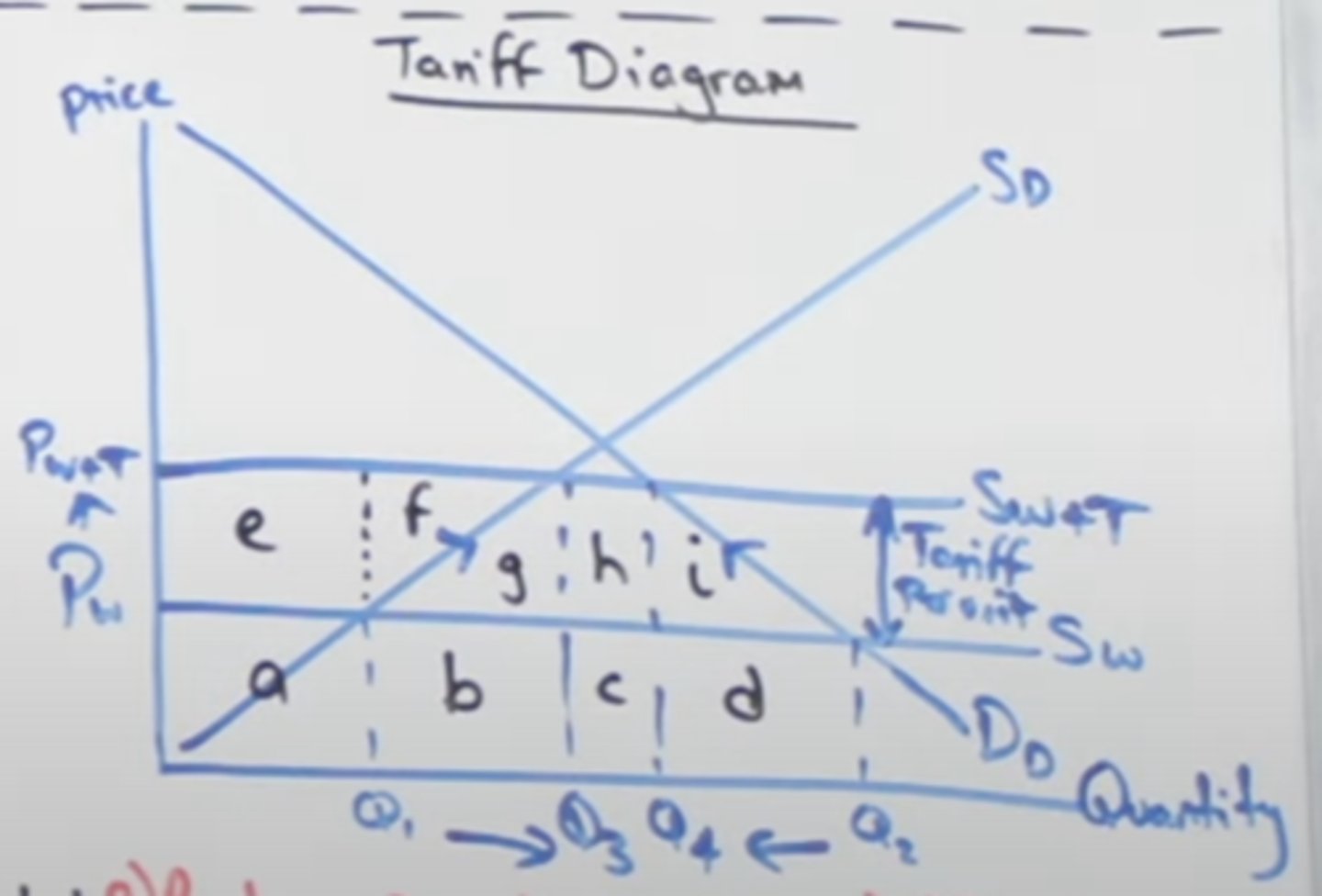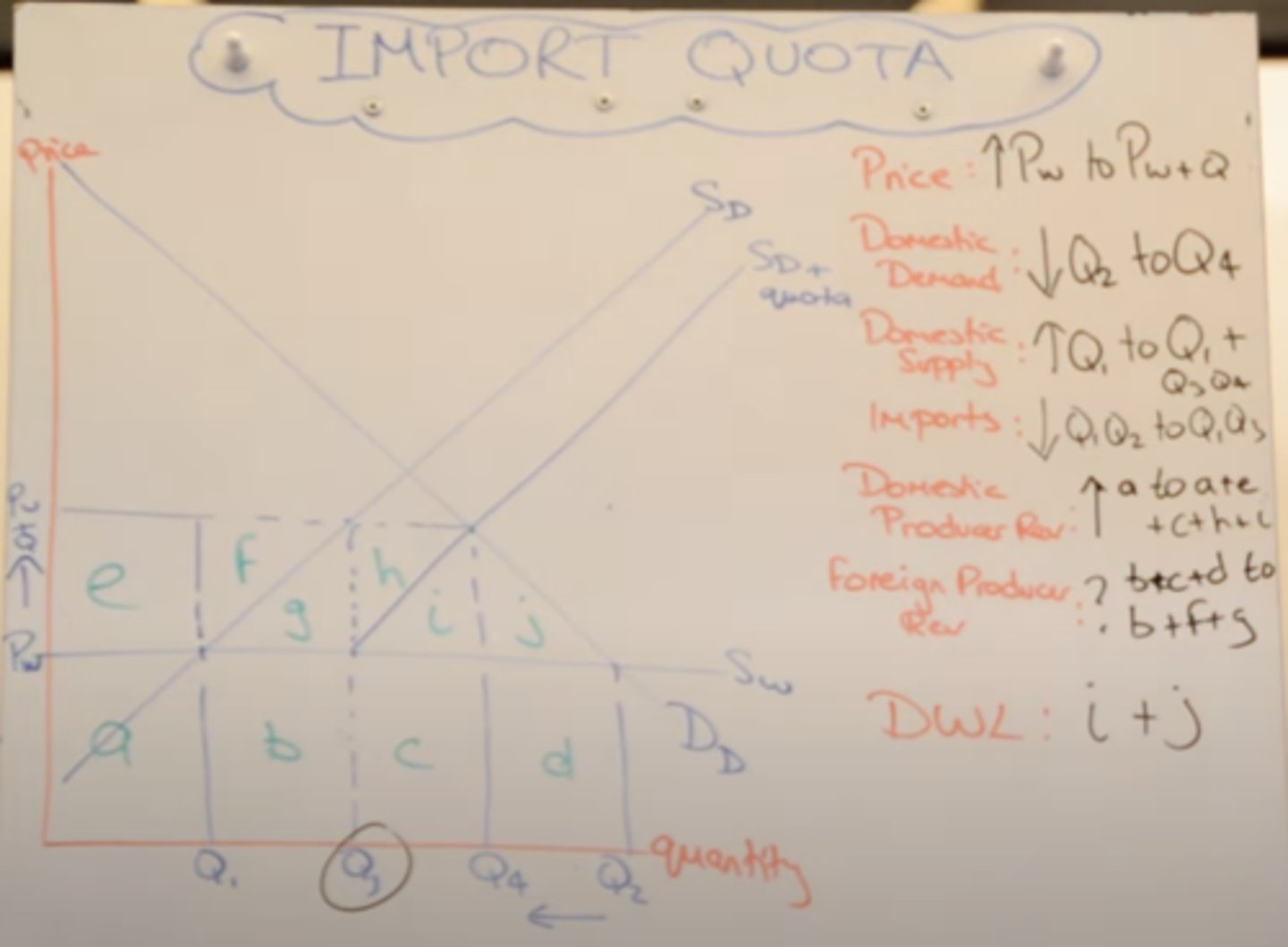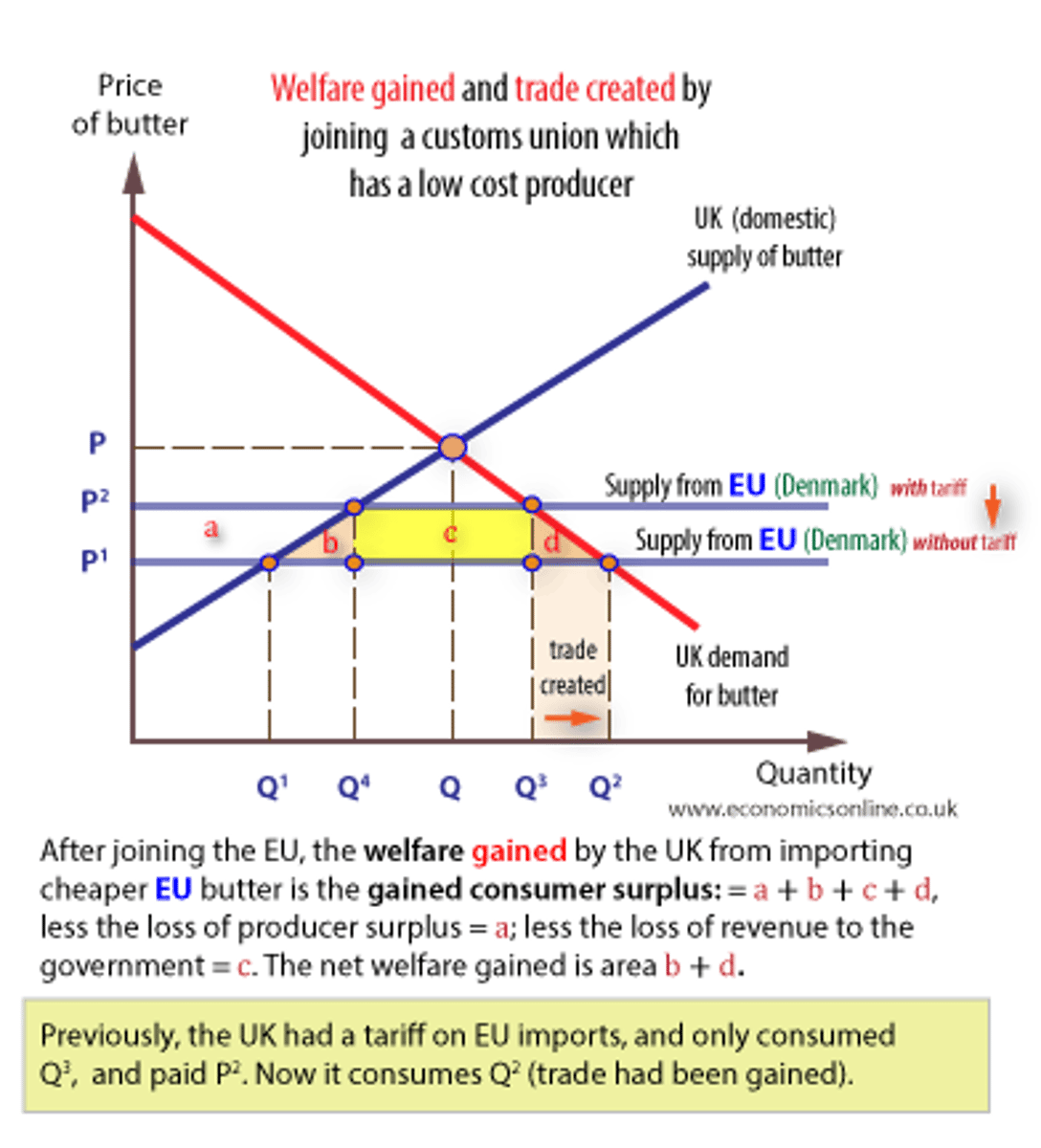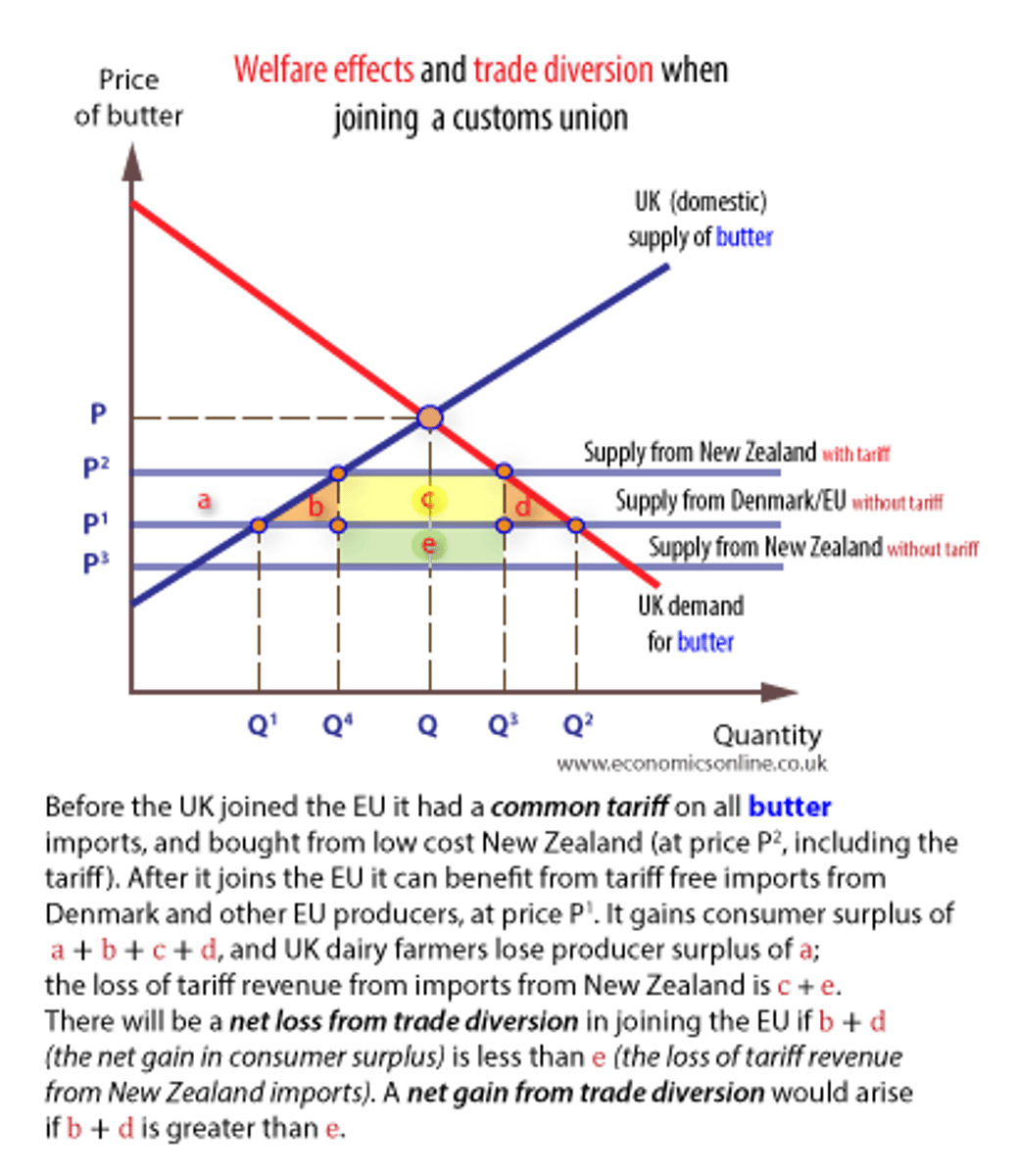trade policies and negotiations
1/50
There's no tags or description
Looks like no tags are added yet.
Name | Mastery | Learn | Test | Matching | Spaced |
|---|
No study sessions yet.
51 Terms
What is protectionism?
the practice of shielding one or more industries within a country's economy from foreign competition through the use of tariff or non-tariff barriers
what are three methods of protectionism
tariffs, quotas, regulations
why would a country engage in protectionism - infant industries
- Infant industries struggle to compete with established foreign firms due to a lack of economies of scale, so protectionist boundaries allow them to grow, become competitive and eventually export
why would a country engage in protectionism - prevent dumping
Dumping occurs when foreign firms sell goods below cost to undercut domestic producers and dominate the international market
protectionist measures counteract this unfair competition
why would a country engage in protectionism - safeguarding jobs
- protectionist barriers prevent mass unemployment in large sectors struggling to compete against cheaper foreign competitors
why would a country engage in protectionism - correcting BoP deficit
- excessive imports lead to a BoP deficit in the current account, which can weaken the economy and currency depreciation. it can also make the economy too overreliant on imported goods especially those that are neccessitites
- protectionist barriers reduce the deficit, stabilise the exchange rate and prevent overreliance
What is a tariff?
A tax levied on imported goods passed onto consumers in the form of higher prices
Tariff diagram
analysis to price, the quantity of domestic supply, quantity of domestic demand, domestic producer revenue, gov revenue, foreign producer revenue, consumer surplus, deadweight loss, producer surplus, allocative efficiency
- price increases from Pw to Pw+t
- extension in domestic supply from Q1 to Q3
- contraction of domestic demand from Q2 to Q4
- increase in domestic producer rev from 'a' to 'a+b+e+f+g'
- gov rev area 'h' (price of tariff x imports)
- foreign producer rev from 'b+c+d' to only 'c'
- loss of consumer surplus 'e+f+g+h+i'
- deadweight loss of efficiency + deadweight loss of consumer surplus 'i+g'
- producer surplus gain from 'half a' to 'half a +e+f'
- allocative inefficiency 'g' as this is the extra cost involved in units being produced by domestic suppliers domestic suppliers don't have the comparative advantage so they produce them at a higher cost which is inefficiency so allocative efficiency worsens

Explain retaliation as a consequence of a tariff as a form of protectionism
the country affected by the tariff may retaliate with their own tariff which can lead to a trade war where both countries raise tariff or non-tariff barriers making trade more expensive and inefficient
how does the elasticity of domestic demand and supply affect the extent to which a tariff is beneficial
- intention of a tariff is to reduce imports but off both demand and supply are inelastic, then the contraction and expansion will actually be quite small thus the fall in imports will be small
What is a quota?
a limit set by a country on the amount of a specific good that can be imported within a time period
quota diagram
analysis to price, the quantity of domestic supply, the quantity of domestic demand, domestic producer revenue, foreign producer revenue, consumer surplus, deadweight loss
- quota is set at Q3 so there is excess demand that can't be satisfied by imports which pushes up the price, so new domestic suppliers enter the market, shifting the supply curve
- price increases
- domestic demand contracts from Q2 to Q4
- domestic supply from Q1 to Q1 Q3 Q4
- imports fallen from q2-q1 to q3-q1
- domestic producer revenue increased from 'a' to 'a+e+c+h+i'
- foreign producer revenue has changed from 'b+c+d' to 'b+f+g'
- loss of consumer surplus 'j'
- deadweight welfare loss of consumer surplus and world efficiency 'i+j' due domestic suppliers producing at a higher cost as they don't have the comparative advantage

what is a trade subsidy
how does it impact producers
diagram
how does that impact the market
what is a negative to a gov giving a subsidy
a grant given to domestic producers to lower their cost of production and make them more competitive
- decreases their cost of production allowing them to increase their supply → shift supply right
- domestic prices fall, so domestic consumers will switch to cheaper option, reducing quantity of imports, thus reducing trade
- but subsidies incur as a cost to governments to may worsen a budget deficit
why would a country impose protectionist barriers to protect against supply-side shocks
give a real-life example of this
- to not be too reliant on necessary goods like food, or military equipment as overreliance could be disastrous in a supply-side shock
- For example trump's 2018 steel tariff to protect defence manufacturing in wartime
why would a country impose a protectionist barrier: sunset industries
what is the trade-off - allocative efficiency + long run short run
- The sunset industry is one that expects a long-term decline
- often large number of workers are employed, so the collapse of this would cause mass unemployment so to prevent this, introduce protectionism
- the trade-off is that this works in the short run but delays the inevitable, workers could be reallocated to more productive industries but instead, resources are being used inefficiently thus harming allocative efficiency
- in the long run, this fails, as sunset industries need continuos gov support leading to permanent inefficiency
why would a country introduce protectionism: protecting infant industries
what could be an issue
- Infant industries are those that are emerging
- they need temporary protection from foreign competition to allow them to develop economies of scale to compete internationally
-the issue is that it is difficult to remove the protectionist policy after a while, and moral hazards arise if firms expect permanent gov support like subsidies
impact of protectionism to consumers
higher prices leading to deadweight welfare loss of consumer surplus and less choice
impact of protectionism on domestic producers
- domestic producers will see a higher producer surplus
- but their incentive to become more efficient will be low in the long run due to less competition so they may never be able to compete effectively in world markets
- overreliance on gov could cause complacency
impact of protectionism on government
- tariff increases gov rev which can be used for public spending, especially for countries with weak tax collection systems
- tariffs reduce imports so the current account can improve, but if producers are not able to respond by increasing production, then the benefit from a tariff will be lower
impact of Protectionism on the Market and efficiency
- tariff distorts market efficiency leading to higher prices and lower output and loss in world efficiency and loss in consumer surplus
impact of protectionism on equality
protectionism benefits producers at the expense of consumers worsening equality
- low-income consumers suffer more as they spend a higher proportion of their income on everyday goods like food, which increase in price, thus disproportionately affecting low-income households worsening equality
Define free trade
the unrestricted movement of goods and services across international borders
how does free trade support allocative efficiency
what does this do to the price
how is a competitive environment affect firms and their prices
Free trade allows resources to be allocated to their most productive uses
- without trade barriers firms produce at lower opportunity costs due to specialising in comparative advantage reducing waste and inefficiency
- prices fall, making goods more affordable
- due to vast firms, a competitive environment is fostered, thus all firms aim to become more productively efficient and grow from selling to international markets thus allowing huge potential to gain economies of scale leading to lower prices
How does free trade lead to higher economic growth and employment: maximisation of output + economies of scale + MNCs (capital accumulation)
- specialisation under comparative advantage means factors of production are utilised in productive sectors maximising output and efficiency
- free trade expands the market size, allowing major benefits from economies of scale, leading to firms' ability to invest and expand further leading to greater employment levels and greater output
- FDI is attracted as MNCs set up in countries with open international markets leading to more job creation, infrastructure development, and capital accumulation contributing to long-term economic growth
explain increasing inequality as a criticism of free trade
- developed countries gain more than developing countries as developed countries specialise in high-value industries while developing nations specialise in primary sector
- ToT deteriorates over time for developing countries as suggested by the prebisch-singer hypothesis suggests
- increasing inequality throughout world
explain the collapse of infant industries as a criticism of free trade
- developing countries cannot compete with established MNCs
- protectionist measures like tariffs & and subsidies help protect infant industries until they achieve economies of scale whereas free trade would not allow this
how is geopolitical instability a criticism of free trade
- some industries are too important to depend on foreign supply like defence and agriculture
- geopolitical instability can be detrimental if a country is overreliant on global supply chains
- this can be a threat to national security and economic stability
define economic integration
the process of countries becoming more interconnected and interdependent
what are the stages of economic integration
free trade area
customs union
common market
monetary union
economic union
what is a free trade area
give example
Where all barriers are removed between members of the bloc. But individual members can still impose barriers on non-members.
e.g. NAFTA
what is a customs union
give example
eliminates trade barriers between member countries and adopts a common external trade policy
e.g. MERCOSUR
what is a common market
give example
group of countries have no trade barriers between each other and a common external tariff to non-member countries AND allow the free movement of labour and capital
e.g. European economic community (EEC)
what is a monetary union
give example
group of countries with no trade barriers, external tariff to non-member countries, free mobility of capital and labour AND a shared currency and central bank with a common monetary policy
e.g. Eurozone controlled by European central bank
what is an economic union
give example
group of countries with no trade barriers between, common external tariff, free mobility of capital and labour, shared currency and central bank and monetary policy AND common economic policy, with common laws and economic regulations
e.g. united kingdom and united states
what is a trading bloc
A trading bloc is a group of countries that are near each other and promote trade among themselves
What is trade creation?
Movement from a high-cost domestic producer to a low-cost producer within the trading bloc as a result of joining a trading bloc
trade creation diagram, explain it
impact to consumers
impact on domestic producers
impact on gov
impact on society
- initially, domestic countries' imports were P2 and imports were Q4 - Q3
- then joins the trading bloc, so the tariff is removed so price decreases to P1 causing an extension in domestic demand and a contraction in domestic supply
- consumers see lower prices, so an increase in purchasing power + greater consumer surplus + increased consumer choice
- domestic producers lose market share to cheaper imports + new competitors may push them to become more productively and dynamically efficient
- gov sees loss in rev due to removal of tariffs
- there is a net welfare gain in society

What is trade diversion?
when a country joins a trading bloc and shifts its imports from a more efficient producer outside the bloc to a less efficient one inside the bloc
Trade diversion diagram, explain it
impact on consumers, producers in bloc and out of bloc & domestic producers
impact on world efficiency
- initially, the country imported from a non-member with cheap prices
- joins trading bloc, adopts CET, so the price of non-member country is driven up
- member states enter the market, and supply at a cheaper price due to no tariffs
- now country will import from member states not because of comparative advantage or gains in efficiency but due to trading rules
- consumers see a deadweight loss in consumer surplus as a result of the increase in price and a contraction in demand
- producers from the bloc benefit as the market size expands
- original producer loses access to the market due to tariff barrier
- domestic producer surplus increases
- deadweight loss in domestic efficiency as domestic firms cost more to produce the good
- loss of world efficiency as it costs the trading bloc members more to produce good than the original country

what is the WTO
what is their primary objective
World Trade Organization is an international organisation that regulates and promotes trade among 164 member states
- primary objective is to facilitate free trade by removing trade barriers and ensuring trade policies are fair, predictable and non-discriminatory
What does the WTO think trade should be like ideally
- non-discriminatory: countries should not favour one trading partner over another
- free from trade barriers
- predictable: trade policies, tariffs and regulations should be clear and stable to build trust and confidence for investors
- fair competition to prevent dumping, and unfair subsidies so countries compete based on real efficiency and comparative advantage
- beneficial to developing countries - they are limited in being able to compete so WTO includes flexible rules and support systems to help them grow through trade
what are the main functions of the WTO
Functions:
1) set and enforce rules for international trade
2) provide a forum for negotiating and monitoring further trade liberalisation
3) resolve trade disputes;
4) increase the transparency of decision-making processes;
5) cooperate with other major international economic institutions involved in global economic management
6) help developing countries benefit fully from the global trading system
what are the advantages of a country joining the WTO: MNCs
countries joining the WTO become more attractive to MNCs due to their commitment to stable trade policies
- FDI inflows boost employment, improve skills through knowledge and transfer and increase economic growth
- MNCs contribute to exports expanding the country's participation in international markets
how can the joining the WTO increase efficiency in a country
- by removing trade barriers, the WTO allow countries to specialise where they have a comparative advantage, which increases efficiency as resources are allocated to the most efficient sector, furthermore, increased access to global markets pushes countries to become more competitive thus increasing efficiency
how is the WTO preventing unfair trade practices an advantage to countries
- WTO discourages unfair practices like dumping, where foreign firms sell goods below cost to drive new competition out of the market
- WTO protects industries by stopping unfair practices, preserving jobs and economic stability
- especially helpful for developing economies as they struggle due to infant industries not having gained economies of scale yet
WTO criticism for infant industries
- if a developing economy removes barriers too quickly, and the removal is not timed perfectly, the infant industries would collapse as they compete with the MNCs, so they may fail before any economies of scale are gained
WTO criticism to weak enforcement on labour standards
- WTO does not allow a country to ban imports from another country based on their production methods
- this reduces pressure on countries to provide good working conditions, or stop child labour
WTO criticism of environmental exploitation
- higher trade volumes lead to faster depletion of non-renewable resources which the WTO ignores
WTO criticisms : slow dispute regulation process
- slow dispute regulation processes mean conflicts can take years to resolve which is inefficient
- other countries may be discouraged to file complaints against other countries engaging in unfair practices which actually goes against the WTO's objective of fair competition
WTO criticism - causing structural unemployment
free trade forces industries to restructure, leading to job losses that may cause structural unemployment
overall evaluation of the WTO
WTO plays a critical role in global trade by removing trade barriers, promoting economic growth and ensuring fair competition
- but its effectiveness depends on; how well countries adapt to competition (firms must innovate and improve efficiency), how monetary gains are distributed (gov must reinvest gains from trade into public services), how quickly trade disputes are resolved (slow WTO rulings may reduce trust in teh system)
- despite the challenges, the long queue of countries waiting to join the WTO suggests that most nations see it as a path to greater economic prosperity
- but whether free trade improves living standards depends on how the economies manage the transition and mitigate risks such as inequality and environmental damage